The Ashy Drongo, a medium-sized member of the Dicruridae family native to South and Southeast Asia, captivates birdwatchers and ornithologists alike with its distinctive ashy grey plumage and iconic forked tail.
However, its allure extends beyond its striking appearance. Renowned for its remarkable mimicry skills, this bird can imitate various calls from other species, showcasing unparalleled versatility in communication.
Such behavior sparks intrigue among researchers delving into animal communication dynamics. Furthermore, the Ashy Drongo exhibits clinal variation across its range, presenting enthusiasts with both challenges and rewards in identifying individuals.
Join us on a captivating journey as we unravel the mysteries of this intriguing avian species.
Physical Characteristics of the Ashy Drongo
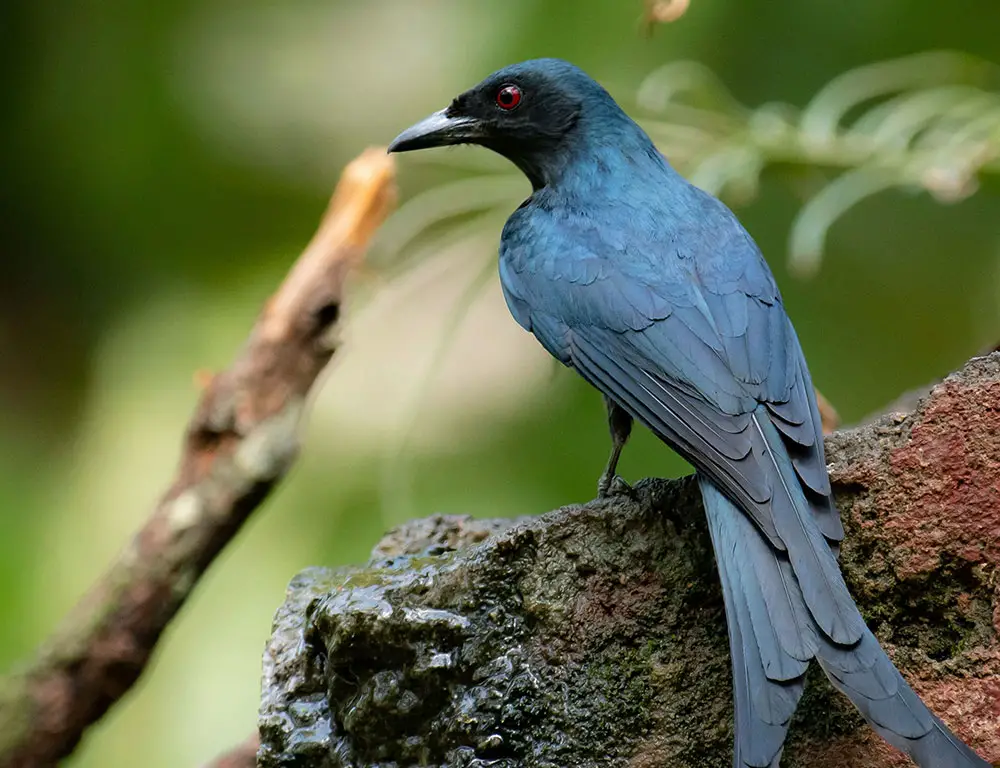
The Ashy Drongo (Dicrurus leucophaeus) possesses several unique physical characteristics that contribute to its distinct appearance and adaptability.
Here’s an overview of its physical traits:
Coloration
The Ashy Drongo is primarily characterized by its ashy gray plumage, which covers most of its body. This coloration gives the bird its name. However, its eyes stand out with their vibrant red color, creating a striking contrast against the gray feathers.
Size
Despite being relatively small compared to other drongos, with an average length of around 30 cm, the Ashy Drongo is known for its tenacity and agility. Despite its size, it can hold in various environments and situations.
Tail
One of the distinctive features of the Ashy Drongo is its elongated forked tail, a characteristic not commonly found among other members of the Drongo family. This unique tail shape enhances its visual appeal and aids in flight, providing stability and maneuverability.
Legs and Feet
The Ashy Drongo has short legs but strong feet equipped with sharp claws. These features are well-suited for perching on branches and catching prey mid-flight, demonstrating the bird’s adeptness in terrestrial and aerial activities.
Basic Stats
- Average Length: Around 30 cm
- Weight Range: Typically between 42-60 grams
- Wingspan: Ranges from 34 to 41 cm when fully extended
Habitat and Distribution of the Ashy Drongo
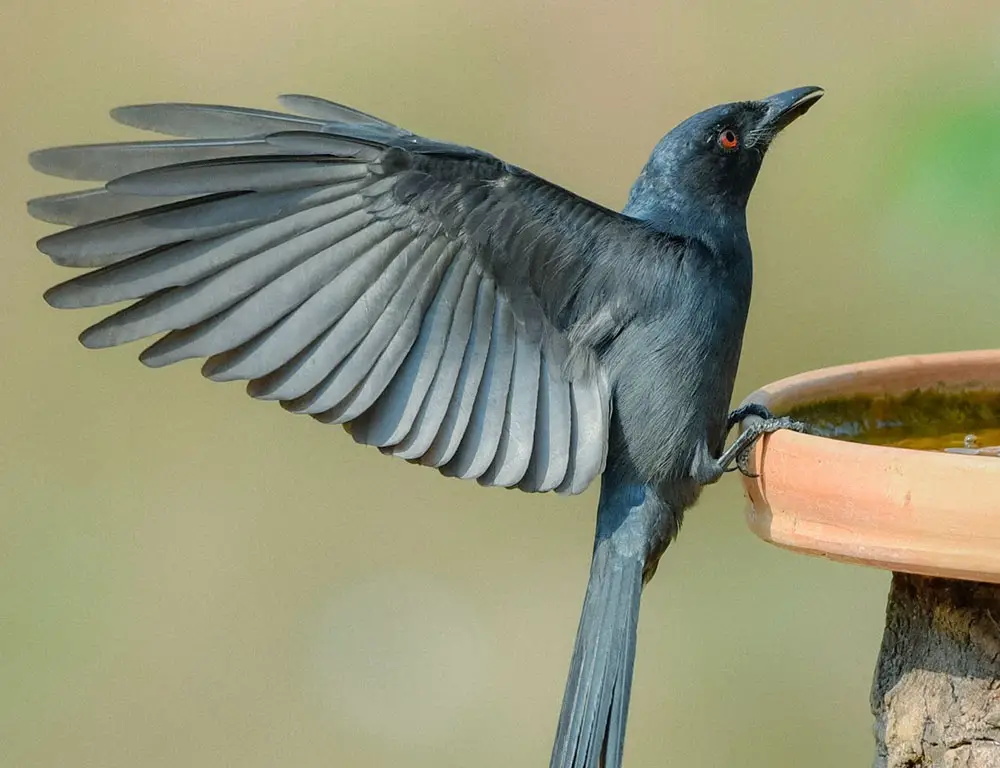
The Ashy Drongo (Dicrurus leucophaeus) is indeed a fascinating bird species with a diverse habitat and distribution pattern. Native to Asia, particularly South and Southeast Asia, the Ashy Drongo showcases a remarkable adaptability to various environments within its range.
Geographic Range
The Ashy Drongo’s distribution spans a wide area, extending from India across Southeast Asia to southern China. This range covers diverse ecosystems and landscapes, from the dense forests of northeastern India to the urban parks and gardens of Southeast Asian cities.
Habitat Preferences
While the Ashy Drongo is commonly found in open forests and woodlands, it demonstrates versatility in its habitat selection.
They are also frequently spotted in parks, gardens, and even urban areas as long as suitable perching sites and an adequate food supply, primarily insects, are available.
Seasonal Adaptations
Ashy Drongos exhibit seasonal changes in their habitat use. During the breeding season, typically from March to July, they favor deciduous forests and plantations.
However, as winter approaches, they migrate towards warmer regions such as peninsular India, displaying their ability to adapt to changing environmental conditions.
Subspecies Variation
The Ashy Drongo’s wide-ranging habitat is further segmented into different subspecies, each with its geographic preference:
- D. l. longicaudatus: Prevalent in northeastern India.
- D. l. hopwoodi: Favors northwestern India.
- D. l. leucogenis: Prefers southern China.
Adaptability and Variety
Overall, Ashy Drongo’s ability to thrive across various habitats and its extensive geographic distribution highlight its adaptability and resilience as a species.
From bustling urban areas to remote forests, and from cold northern zones to warmer southern regions, the Ashy Drongo exemplifies a remarkable capacity to embrace environmental diversity throughout its life cycle.
Behavior and Diet of the Ashy Drongo
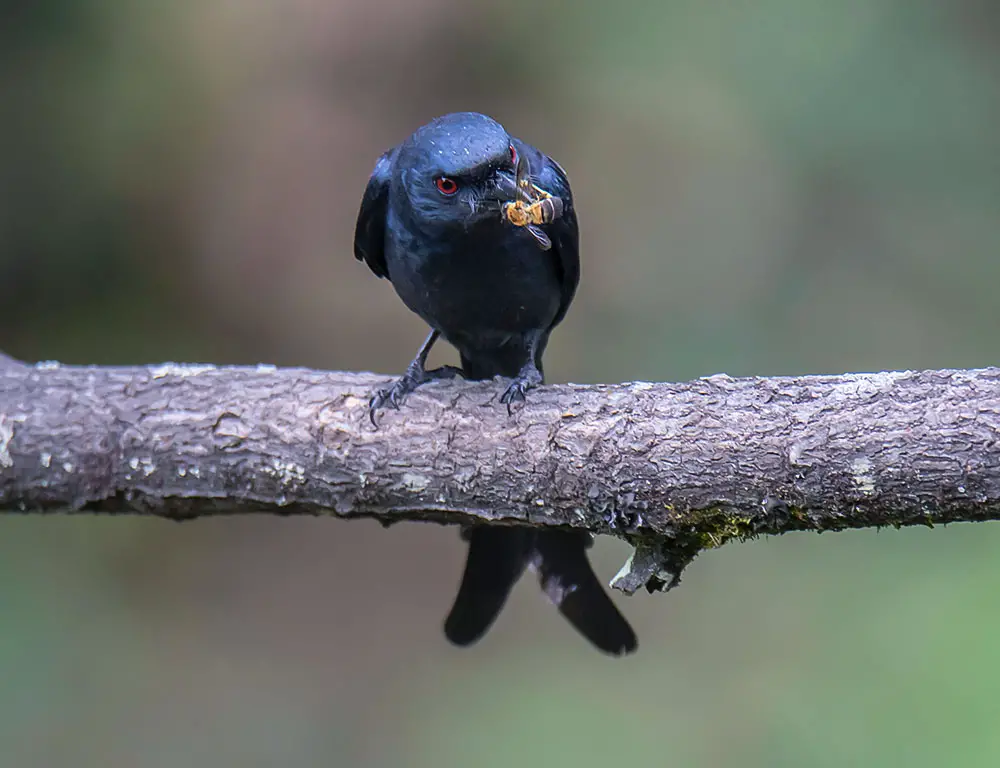
The Ashy Drongo (Dicrurus leucophaeus) indeed exhibits a fascinating array of behaviors and dietary preferences, contributing to its captivating nature as a subject of study.
Here’s a breakdown of its behavior and diet:
Active Behavior
Ashy Drongos are known for their agility and high activity levels throughout the day. They are often observed flying and foraging in various habitats, demonstrating their energetic nature.
Vocalizations
The Ashy Drongo is notable for its loud and varied calls, which are frequently heard at dawn or dusk. These vocalizations serve multiple purposes, including communication within the species and territorial defense.
Territoriality
Ashy Drongos exhibit territorial solid behavior, particularly during the breeding season. They fearlessly defend their territory and may aggressively interact with larger birds encroaching on their space.
Mimicry
One of the most intriguing behaviors of the Ashy Drongo is its ability to mimic the calls of other bird species.
This skillful mimicry is believed to serve various purposes, such as attracting mates, confusing predators, or even mimicking alarm calls to warn other birds of potential threats.
Dietary Preferences
Ashy Drongos have a diverse diet and are not selective eaters. Their meals primarily consist of insects such as beetles, caterpillars, and locusts, which they catch in mid-air using a hunting technique known as ‘hawking.’
They also consume berries and nectar, showcasing their opportunistic feeding behavior.
Foraging Behavior
The Ashy Drongo employs various foraging techniques, including aerial hawking to catch insects on the wing and searching for berries and nectar in vegetation.
Their versatility in foraging allows them to exploit different food sources based on availability and season.
Breeding and Reproduction Habits of the Ashy Drongo
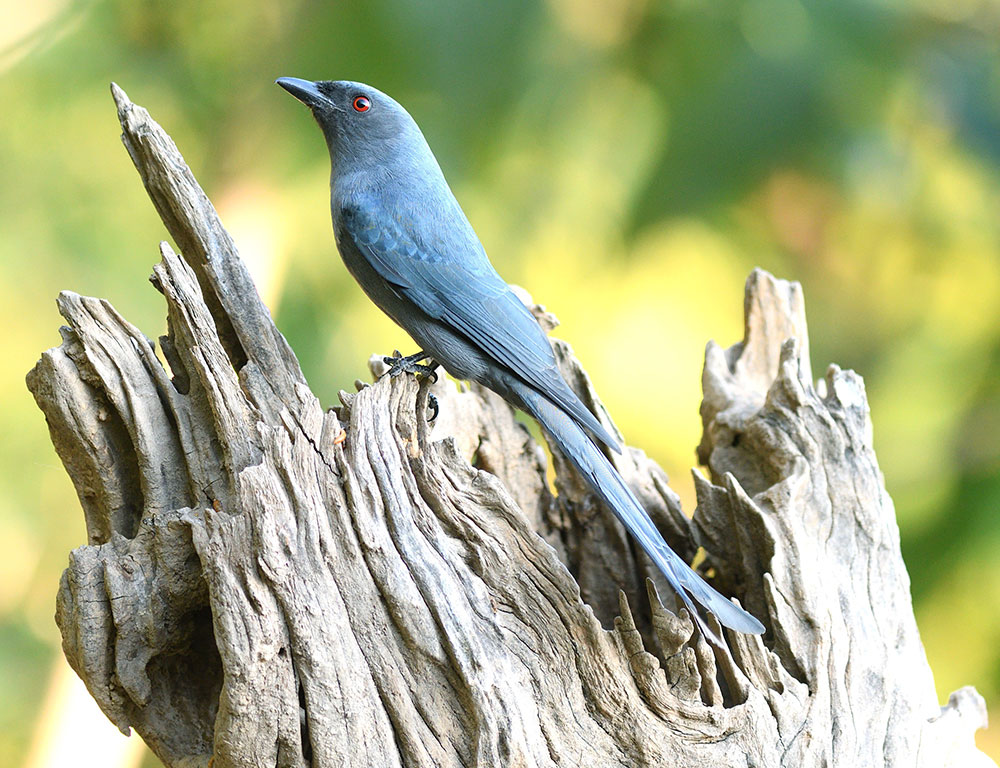
The breeding and reproductive habits of the Ashy Drongo (Dicrurus leucophaeus) are indeed fascinating, characterized by elaborate courtship displays, shared nest-building duties, and cooperative care of offspring.
Here’s an overview of their breeding behavior:
Breeding Season
Ashy Drongos typically breed during the warmer months, with breeding activity peaking from April through July. Their reproductive behavior becomes highly noticeable during this period as they engage in courtship displays and nest-building activities.
Courtship Displays
Male Ashy Drongos showcase elaborate courtship displays to attract potential mates. These displays often involve aerial acrobatics, including swooping dives and intricate mid-air twists, demonstrating the male’s agility and fitness.
Nest Building
Once a mate is secured, both male and female Ashy Drongos participate in nest-building. The nests are shallow cups constructed from twigs and leaves, with finer materials used to line the interior for comfort and insulation.
Egg-laying and Incubation
Female Ashy Drongos are primarily responsible for egg-laying and incubation. They lay an average of 3-5 eggs per clutch, pale cream or pinkish and speckled with brown or grey spots.
The incubation period lasts approximately two weeks, during which the female relies on her partner for food and protection.
Parental Care
Both parents are responsible for caring for the hatchlings after they emerge from the eggs. They take turns feeding the nestlings and providing protection against predators.
This cooperative parental care continues until the offspring are ready to fledge and begin their independent life.
Conservation Status of the Ashy Drongo
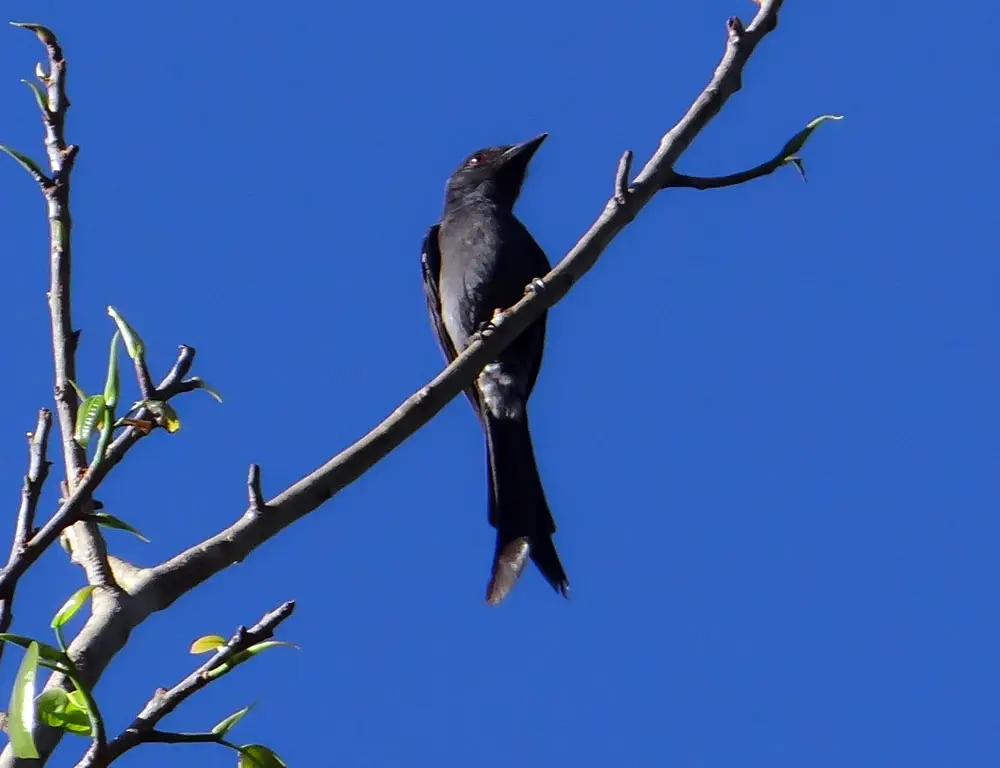
The Ashy Drongo (Dicrurus leucophaeus) is currently classified as “Least Concern” by the International Union for Conservation of Nature (IUCN), indicating that the species is not currently facing imminent extinction threats.
However, despite this classification, there are several important factors to consider regarding its conservation status:
Habitat Loss
One of the primary threats to the Ashy Drongo population is habitat loss due to deforestation and land conversion for agriculture. The destruction and fragmentation of their natural habitats can significantly impact their ability to find suitable nesting sites and food sources.
Human Activity
Human activities, including urbanization and infrastructure development, pose additional risks to Ashy Drongo populations.
As adaptable birds, they can be found in various habitats, including urban areas, but they still face challenges such as habitat degradation and pollution.
Climate Change
Climate change is another concern that could potentially affect Ashy Drongo populations. Temperature and precipitation patterns may alter their migration routes and breeding seasons, disrupting their life cycles and population dynamics.
Monitoring and Conservation
Despite their adaptability, ongoing monitoring and conservation efforts are essential to ensure the long-term survival of Ashy Drongos.
Conservation measures may include habitat preservation, restoration initiatives, and raising awareness about protecting their natural habitats.
Conclusion
The Ashy Drongo captivates with its adaptability, mimicry prowess, and vital ecological roles. Thriving across Asia it exemplifies nature’s resilience. Feeding on insects it aids pest control, while its annual breeding showcases cooperative parenting.
Remembering its habitat adaptability and mimicry talents is critical. Yet, its essence goes beyond biology; it symbolizes our ongoing journey in understanding and preserving biodiversity.
With its endless revelations, ornithology underscores our interconnectedness with nature’s marvels. Each discovery enriches our appreciation of life’s intricate tapestry.
In our quest for knowledge, let’s cherish every encounter with these winged wonders, embracing the profound lessons they offer about our shared existence.